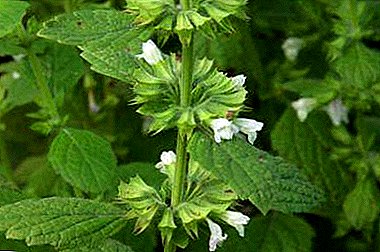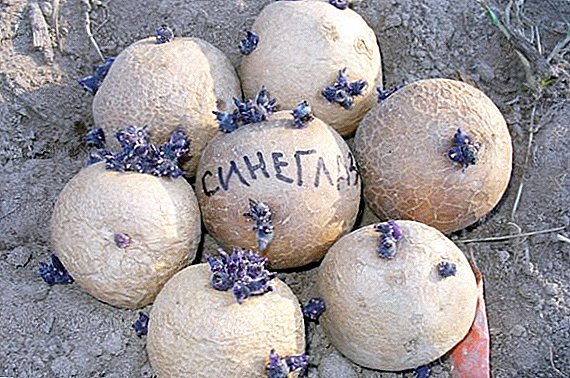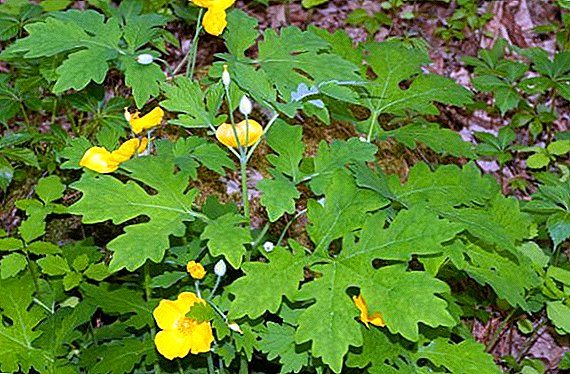 Buttercup creeping - bright, juicy, but very dangerous plant. In ancient times, its properties were often used against enemies: it was enough to add a small amount of it to food or drink - and the final was a foregone conclusion. At the same time, it can be of great benefit, since it also has healing power. Let's take a closer look at it.
Buttercup creeping - bright, juicy, but very dangerous plant. In ancient times, its properties were often used against enemies: it was enough to add a small amount of it to food or drink - and the final was a foregone conclusion. At the same time, it can be of great benefit, since it also has healing power. Let's take a closer look at it.
Biological description
The creeping buttercup belongs to the Buttercup family and is widely distributed in Eurasia and in northwestern Africa. It grows on alluvial soils, in wet and shaded places: on the banks of reservoirs, lowlands, swamps, etc. This is a grassy perennial plant 15–40 cm high, which has a thick, juicy, creeping or ascending stem and a short branching root system. The leaves at the root are petioled, tridentary with different teeth, the upper leaves are sessile, lanceolate and also tridentary. The creeping buttercup begins to bloom in June with regular, bisexual flowers with 5 bright yellow petals and a large number of stamens and pistils. They can be single apical or grouped into a semi-umbrella. The crown of the plant is 2-3 cm in diameter. Buttercup is pollinated by insects, and its fruits are multi-webs, that is, a nut fruit, surrounded by a firm pericarp.
The creeping buttercup begins to bloom in June with regular, bisexual flowers with 5 bright yellow petals and a large number of stamens and pistils. They can be single apical or grouped into a semi-umbrella. The crown of the plant is 2-3 cm in diameter. Buttercup is pollinated by insects, and its fruits are multi-webs, that is, a nut fruit, surrounded by a firm pericarp.
On the composition and benefits
The description of a plant called buttercup creeping will be incomplete without the history of the origin of the name of the flower: despite the poetic nature of its name, it comes from the word "fierce", that is, burning, corrosive, poisonous. Its chemical composition includes tannins and nitrogen-free non-toxic compounds, easily soluble in water and alcohol. Under the influence of oxygen oxidation occurs, and buttercup tinctures change their color to brown.
Check out the technique of growing buttercup garden.Alkaloids present in it have a positive effect on the central nervous system, muscles and blood vessels. In addition, they normalize pressure and body temperature. Coumarins have a softening, anticoagulant effect, reduce blood clotting, increase body tone and saturate it with vitamins of group R. Flavonoids are actively involved in the body's redox processes, and vitamin C is indispensable for colds.
Important! Buttercup creeping breeds well and does not require special care. Its cultivation is not difficult even for beginners.

Chemical composition of the plant
Buttercup creeping has a rich chemical composition of the following substances:
- protoanemonin;
- coumarin;
- saponin;
- cardiac glycosides;
- tannins;
- flavonoids (neovitexin, vitexin, saponaretin);
- alkaloids;
- vitamin C;
- hinoin;
- carotene.
Use in traditional medicine
Buttercup creeping has found its use in the treatment of many diseases. However, given its dangerous properties, the plant is mainly used externally. Inside it is taken only after consulting a doctor and is used to treat migraines, epilepsy, neurosis, and other nerve pathologies. In addition, it is used to stop bleeding for hemorrhoids and gynecological problems.
Also to stop bleeding use nettle, longan, raspberry leaves, graviatat, comfrey, skumpiyu and cloudberries.Creeping buttercup also helps to cope with diseases of the joints, muscles and bones, as it has an analgesic, antimicrobial and healing effect. It also helps with problem skin conditions - abscesses and abscesses, contributing to their rapid resorption and maturation. Buttercup fights scabies, warts and fungal infections of the feet and nails. Compresses and poultices with it relieve pain and eliminate spasm of radiculitis, rheumatism, arthritis, osteochondrosis, gout and other muscular and locomotor diseases.
Contraindications
According to the description of a creeping buttercup, besides its complete intolerance, contraindications to the use of this plant as a means of traditional medicine are:
- state of pregnancy;
- lactation;
- young age (under 18);
- chronic diseases in the acute stage;
- the presence of somatic diseases;
- tendency to allergic reactions.

How to grow a creeping buttercup
To grow a creeping buttercup on your site, you need to know where and under what conditions it grows in the natural environment. Properly planted plants will actively multiply and will not require much effort to maintain the plantation.
Did you know? Spread lashes of one plant can reach a length of 3 m.
Where to plant: necessary conditions
As in nature, in artificial conditions this buttercup grass prefers shady and calm places. It can also grow in sunny areas, but this arrangement shortens its life cycle significantly. A creeping buttercup will feel great under a spreading, not very thick tree with loose, soft soil. In heavier soils, for example, sandy or loamy sand, it is better to deposit sand and peat mixture before planting. Ideally, the soil absorbs moisture during watering the plant and it does not remain on the surface.
Planting rules perennial
To plant medicinal buttercup grass, it is necessary to sow its seeds in boxes for seedlings at the end of winter - early spring. The following rules must be observed:
- seeds sow grooves to a depth of about 2 cm;
- the required temperature of the room is + 10-15 ° C;
- boxes covered with polyethylene;
- after 2-3 weeks, the boxes are transferred to a place with a temperature of about +20 ° C.
 Grown seedlings are moved to a well-heated ground in late spring in late April - early May. It is necessary to prepare pits for planting a depth of 5 cm, the distance between plantings is 10 cm. For drainage, fine gravel is laid at the bottom of the pit. However, this method is rather complicated, since creeping buttercup seeds do not germinate well. Therefore, radical cuttings are most often used for planting, which are planted directly on the site in August-September:
Grown seedlings are moved to a well-heated ground in late spring in late April - early May. It is necessary to prepare pits for planting a depth of 5 cm, the distance between plantings is 10 cm. For drainage, fine gravel is laid at the bottom of the pit. However, this method is rather complicated, since creeping buttercup seeds do not germinate well. Therefore, radical cuttings are most often used for planting, which are planted directly on the site in August-September:- tubers are placed in cold water for 10-12 hours;
- then the tubers are transported down 5 cm deep into the pit;
- a hole is covered with earth, the plants are watered with a small amount of water.
Important! Using a creeping buttercup for treating skin diseases, one should not forget about its poisonous properties. You can not perederzhivat it on the skin, so as not to cause ulceration or necrosis.
Plant Care
The plant does not require complex care. It is necessary to water it regularly, but not unnecessarily, so as not to cause rotting of the roots. Buttercup creeping reacts poorly to drought, its root system can dry out very quickly. The flower multiplies well, an annual sapling can bring up to 3 "babies", and an adult - to 7. Therefore, it is necessary to dig up its roots, detach the "offspring" and drop them to a new place. For good growth and proper formation, the plant needs additional feeding. For this, nitrogen fertilizers are used, for example, Kemira-Lux, which should be applied to the soil 2 times a month. During flowering should make potassium and phosphorus. Must not forget about the preparation of plants for the winter. They need to stop watering with the end of flowering, that is, from about the beginning of September. Next, you should dig up the roots, gently clean them from the ground, dry them, process them with a fungicide and separate the "babies." Tubers are stored until the spring wrapped in plastic wrap, sprinkled with peat soil or sand, in a place with a temperature of + 5-10 ° C. A basement or cellar works well for this purpose. Tubers should be periodically inspected and, if there are signs of infection, process this place with colloidal sulfur. Completely infected tuber is better to destroy.
Must not forget about the preparation of plants for the winter. They need to stop watering with the end of flowering, that is, from about the beginning of September. Next, you should dig up the roots, gently clean them from the ground, dry them, process them with a fungicide and separate the "babies." Tubers are stored until the spring wrapped in plastic wrap, sprinkled with peat soil or sand, in a place with a temperature of + 5-10 ° C. A basement or cellar works well for this purpose. Tubers should be periodically inspected and, if there are signs of infection, process this place with colloidal sulfur. Completely infected tuber is better to destroy.
Did you know? According to legend, the plant became poisonous after Satan tried to hide among his thicket from Archangel Michael.
Diseases and pests of buttercup
The main diseases and pests of creeping buttercup:
- root rot - usually caused by planting a seedling in the soil with unfermented manure, infected seedlings begin to grow slower, turn yellow and die;
- powdery mildew - the leaves and petioles of the plant are covered with a mealy bloom, then blacken and dry out;
- black leg - begins with the appearance of white spots from the bottom of the stem, which later turn brown, and the plant dies;
- rust - fistulas appear on the leaves, which burst and rust powder appears from them;
- perinospora - a disease characterized by a slower development of the plant and the appearance of spots on it;
- Fusarium wilt - appears brown spots on the leaves and stems, lack of treatment leads to the death of the plant;
- Nematodes - an excess of moisture in the root system contributes to the development of worms, which negatively affect the plant until its death.
 Nematophagin BT, which is applied to the soil before planting to a depth of 15-20 cm, helps nematodes well. If a problem has arisen already after planting, the preparation is applied to the wells around the plant. The remaining diseases respond well to fungicides, for example, Zaslonom, Barrier, Baktofit and others.
Nematophagin BT, which is applied to the soil before planting to a depth of 15-20 cm, helps nematodes well. If a problem has arisen already after planting, the preparation is applied to the wells around the plant. The remaining diseases respond well to fungicides, for example, Zaslonom, Barrier, Baktofit and others.Buttercup Weed: How to get rid of a plant in the garden
Rapidly multiplying and covering the soil, this plant drowns out and displaces other crops, especially vegetable. Therefore, many gardeners are wondering: how to get rid of the creeping buttercup? There are several methods for this:
- plowing tools must be used to clean the area, all cut parts must be carefully assembled and disposed of;
- on well-loosened soil, you can use the usual chopper;
- dehumidification or drainage of the site may contribute to the drying of the roots of plants and their death;
- heavily clogged area should be treated with glyphosate;
- complex preparations, which include herbicides, will help to prevent the breeding of a creeping buttercup.












